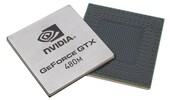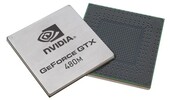NVIDIA GeForce GTX 480M vs NVIDIA GeForce GTX 485M SLI
NVIDIA GeForce GTX 480M
► remove from comparison
The NVIDIA GeForce GTX 480M is a high-end graphics card for laptops based on the Fermi architecture. As a result, it supports DirectX 11 and is produced in 40nm at TSMC. Featuring 352 cores, the GTX480M is similar to the desktop GTX 465 but with a lower clock rate. The GeForce GTX 480M is combined with 2 GB of fast dedicated GDDR5 graphics memory and the overall performance should be generally superior to the Mobility Radeon HD 5870.
The GF100 (aka. Fermi) chip was redesigned from scratch and features 3 billion transistors, assuming all 512 shaders are present. Compared to the desktop HD 5870 with 2.13 billion transistors or the Mobility Radeon HD 5870 (RV870) with 1.04 billion transistors, the GTX 480M die is physically quite large.
The mobile Fermi chip is stripped down to 352 shader cores (1-dimensional) with 32 ROPs and 44 Texture Units. The memory bus is 256 bit wide, but due to the fast GDDR5 memory, this should not be a bottleneck. The power consumption has been specified to 100 Watt TDP when taking into account the MXM board and the 2 GB GDDR5. AMD usually specifies the TDP of the chip alone, therefore this value is not directly comparable with competing Radeon cards. Still, the GTX 480M is only suited for very large desktop replacement (DTR) laptops with an excellent cooling solution. Originally, only Clevo was offering the GTX 480M in its 17" (D901F) and 18" (X8100) barebones.
The performance of the Nvidia GeForce GTX 480M is about 10% better on average than the ATI Mobility Radeon HD 5870. In demanding DirectX 11 games and benchmarks (that make use of the Tessellation engine), the GTX 480M is even faster. That means the GTX480M is the fastest single GPU graphics solution for laptops as of early to mid 2010. Modern DirectX 10 games should run fluently in high resolutions and details with antialiasing. Only very demanding games like Crysis or Metro 2033 may need some reduced settings (see list below). Due to the DirectX 11 hardware support (and the good tessellation implementation), the Fermi based laptop graphics card should be well suited for upcoming DirectX 11 games.
As the GeForce 300M series, the GeForce GTX 480M supports PureVideo HD with VideoProcessor 4 (VP4 with Feature Set C). This means the GPU is able to fully decode HD videos in H.254, VC-1, MPEG-2, and MPEG-4 ASP. The graphics card can also accelerate Flash videos by using Flash 10.1 or greater.
The rendering cores of the Nvidia GeForce GTX 480M can be used for general calculations with CUDA or DirectCompute. For example, the encoding of HD videos can be done significantly faster than most modern CPUs by using the shader cores of the GPU instead. PhysX is also supported by the mobile Fermi chip to calculate physics effects in supported games.
Compared to desktop GPUs, the Geforce GTX 480M is comparable to a nunderclocked Nvidia GeForce GTX 465 (607/1200 clock speed) and is therefore on par with a desktop Radeon HD 5770.
NVIDIA GeForce GTX 485M SLI
► remove from comparison
The NVIDIA GeForce GTX 485M SLI is a high-end laptop graphics solution based on two GTX 485M graphics cards. With SLI, each card usually renders a single frame (AFR mode). Therefore, it may suffer from micro stuttering in low fps ranges of 30fps. This happens because of different timespans between two frames (e.g. irregular delays between sequential frames).
The GeForce GTX485M SLI supports the same features as a single GTX 485M card. Therefore, it supports DirectX 11 and is produced in a 40nm fabrication process at TSMC.
Unlike the GeForce GTX 480M, the 485M is no longer based on a trimmed down GF100 core, but on the GF104 core instead. The latter has been designed for the consumer sector and has 384 cores maximum if completely enabled. More information on the GF104 core can be found on the GTX 485M page.
The performance of the Nvidia GeForce GTX 485M SLI is clearly better than the GTX 480M SLI and is therefore the fastest graphics solution for laptops as of early 2011. It allows the user to play all current games in high resolutions and detail settings with Antialiasing activated. Only Metro 2033 and Crysis may stutter with high Antialiasing and maximum details. Compared to a single GTX 485M, the performance from the SLI combination should be about 40% higher on average (with high details and Antialiasing). Compared to Crossfire solutions by AMD, the Nvdia SLI drivers have the advantage as of this writing.
As the GeForce 300M series, the GeForce GTX 485M supports PureVideo HD with VideoProcessor 4 (VP4 with Feature Set C). This means that the GPU is able to fully decode HD videos in H.254, VC-1, MPEG-2, and MPEG-4 ASP. Using Flash 10.1, the graphics card can also accelerate Flash videos.
What's new in the GF104 chips compared to the GF100 (480M) is the support for Bitstream transfer of HD Audio (Blu-Ray) via HDMI. Similar to the HD 5850, the GTX 485M can transmit Dolby True HD and DTS-HD via Bitstream to compatible receivers without quality loss.
The rendering cores of the Nvidia GeForce GTX 485M can be used for general calculations using CUDA or DirectCompute. In other words, the encoding for HD videos can be done significantly faster by using the shader cores of the GPUs instead of using modern CPUs. PhysX is also supported by the mobile Fermi to calculate physics effects in supported games. Furthermore, a single GTX485M can be used to calculate PhysX while the other card can render frames in the SLI setup.
Compared to desktop GPUs, the Geforce GTX 485M SLI is most similar to two Nvidia GeForce GTX 460 cards running in an SLI configuration.
| NVIDIA GeForce GTX 480M | NVIDIA GeForce GTX 485M SLI | |||||||||||||||||||||||||||||||||||||||||||||||||
| GeForce GTX 400M Series |
|
| ||||||||||||||||||||||||||||||||||||||||||||||||
| Codename | N11E-GTX-A3 | N11E-GTX-A1 | ||||||||||||||||||||||||||||||||||||||||||||||||
| Architecture | Fermi | Fermi | ||||||||||||||||||||||||||||||||||||||||||||||||
| Pipelines | 352 - unified | 768 - unified | ||||||||||||||||||||||||||||||||||||||||||||||||
| Core Speed | 425 MHz | 575 MHz | ||||||||||||||||||||||||||||||||||||||||||||||||
| Shader Speed | 850 MHz | 1150 MHz | ||||||||||||||||||||||||||||||||||||||||||||||||
| Memory Speed | 1200 MHz | 1500 MHz | ||||||||||||||||||||||||||||||||||||||||||||||||
| Memory Bus Width | 256 Bit | 256 Bit | ||||||||||||||||||||||||||||||||||||||||||||||||
| Memory Type | GDDR5 | GDDR5 | ||||||||||||||||||||||||||||||||||||||||||||||||
| Max. Amount of Memory | 2048 MB | 2x2048 MB | ||||||||||||||||||||||||||||||||||||||||||||||||
| Shared Memory | no | no | ||||||||||||||||||||||||||||||||||||||||||||||||
| API | DirectX 11, Shader 5.0 | DirectX 11, Shader 5.0 | ||||||||||||||||||||||||||||||||||||||||||||||||
| Power Consumption | 100 Watt | 100 Watt | ||||||||||||||||||||||||||||||||||||||||||||||||
| Transistors | 3 Billion | |||||||||||||||||||||||||||||||||||||||||||||||||
| technology | 40 nm | 40 nm | ||||||||||||||||||||||||||||||||||||||||||||||||
| Notebook Size | large | large | ||||||||||||||||||||||||||||||||||||||||||||||||
| Date of Announcement | 25.05.2010 | 06.01.2011 | ||||||||||||||||||||||||||||||||||||||||||||||||
| Link to Manufacturer Page | www.nvidia.com | www.nvidia.com |
Benchmarks
3DM Vant. Perf. total + NVIDIA GeForce GTX 480M
specvp11 snx-01 + NVIDIA GeForce GTX 485M SLI
Average Benchmarks NVIDIA GeForce GTX 480M → 100% n=12
Average Benchmarks NVIDIA GeForce GTX 485M SLI → 187% n=12
* Smaller numbers mean a higher performance
1 This benchmark is not used for the average calculation
Game Benchmarks
The following benchmarks stem from our benchmarks of review laptops. The performance depends on the used graphics memory, clock rate, processor, system settings, drivers, and operating systems. So the results don't have to be representative for all laptops with this GPU. For detailed information on the benchmark results, click on the fps number.

Fifa 11
2010
Mafia 2
2010
StarCraft 2
2010
Metro 2033
2010
CoD Modern Warfare 2
2009Average Gaming NVIDIA GeForce GTX 480M → 100%
Average Gaming 30-70 fps → 100%
Average Gaming NVIDIA GeForce GTX 485M SLI → 218%
Average Gaming 30-70 fps → 244%
| NVIDIA GeForce GTX 480M | NVIDIA GeForce GTX 485M SLI | |||||||||||||
|---|---|---|---|---|---|---|---|---|---|---|---|---|---|---|
| low | med. | high | ultra | QHD | 4K | low | med. | high | ultra | QHD | 4K | |||
| Call of Duty: Black Ops | 167 | 125.1 | 128.4 | 119 | ||||||||||
| Fifa 11 | 638 | 426.6 | 307.3 | 199.2 | ||||||||||
| Mafia 2 | 67.1 | 60 | 40.9 | 145.3 | 139.5 | 132.4 | 102.2 | |||||||
| StarCraft 2 | 45.2 | 44.5 | 36.8 | 323.8 | 105.3 | 94.8 | 65.9 | |||||||
| Metro 2033 | 126 | 64 | 33 | 12 | 149.6 | 141 | 89.4 | 31.4 | ||||||
| Battlefield: Bad Company 2 | 108 | 81 | 64 | 38 | 198.2 | 192.4 | 168.6 | 96.8 | ||||||
| CoD Modern Warfare 2 | 78.6 | 68 | 49 | 361.4 | 212.5 | 190.1 | 142 | |||||||
| Risen | 68.4 | 48.7 | 36 | 189.2 | 157.5 | 142.7 | 109.1 | |||||||
| Resident Evil 5 | 150.5 | 96.3 | 59.7 | 202.6 | 143.7 | |||||||||
| Need for Speed Shift | 74 | 77 | 52 | 138.6 | 139 | 126 | ||||||||
| Colin McRae: DIRT 2 | 176.5 | 112 | 83 | 47 | 234.9 | 197.6 | 177.2 | 114.3 | ||||||
| Anno 1404 | 170 | 53 | 228.2 | 138.9 | ||||||||||
| F.E.A.R. 2 | 119 | 61 | 283.8 | 202.4 | 195.9 | 154.3 | ||||||||
| Crysis - GPU Benchmark | 62.3 | 16.1 | 158.2 | 92.8 | 76.7 | 43.3 | ||||||||
| Crysis - CPU Benchmark | 58.3 | 15.5 | 209.5 | 96.7 | 78.6 | 41.4 | ||||||||
| NVIDIA GeForce GTX 480M | NVIDIA GeForce GTX 485M SLI | |||||||||||||
| low | med. | high | ultra | QHD | 4K | low | med. | high | ultra | QHD | 4K | < 30 fps < 60 fps < 120 fps ≥ 120 fps | 1 4 | 1 7 | 4 8 | 3 9 1 | | | < 30 fps < 60 fps < 120 fps ≥ 120 fps | 14 | 3 10 | 4 10 | 3 6 5 | | |
For more games that might be playable and a list of all games and graphics cards visit our Gaming List




































